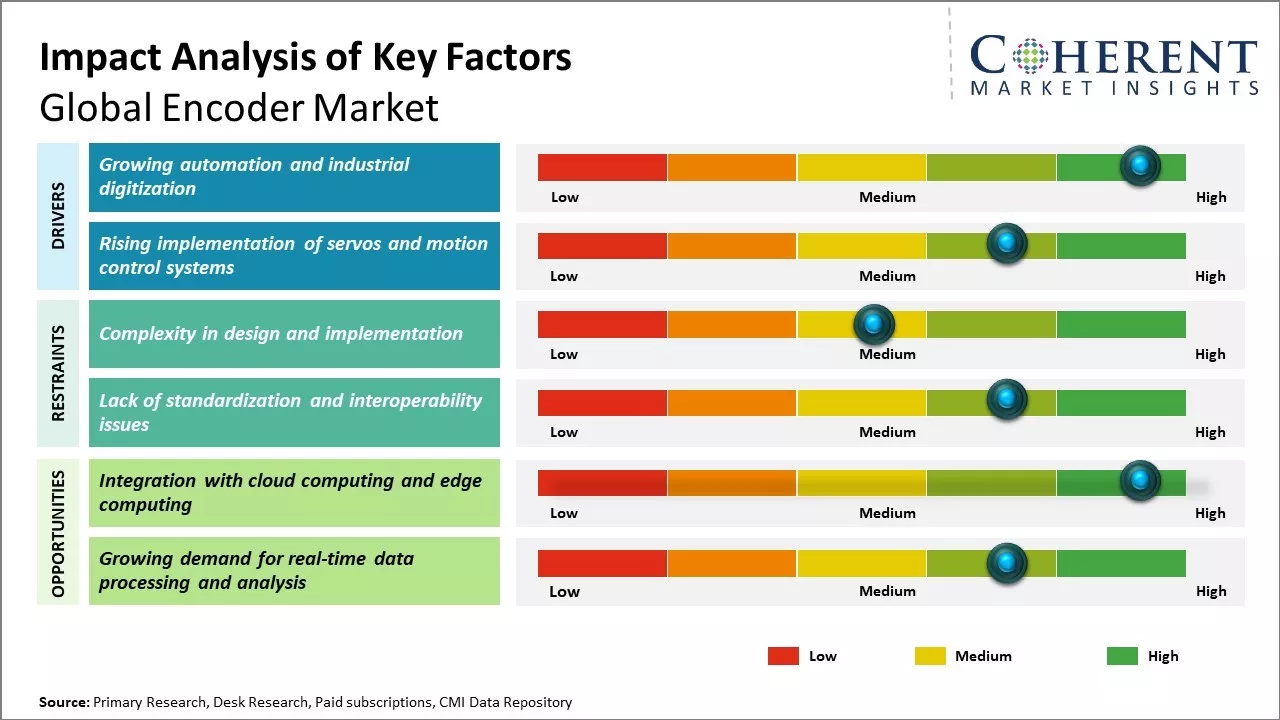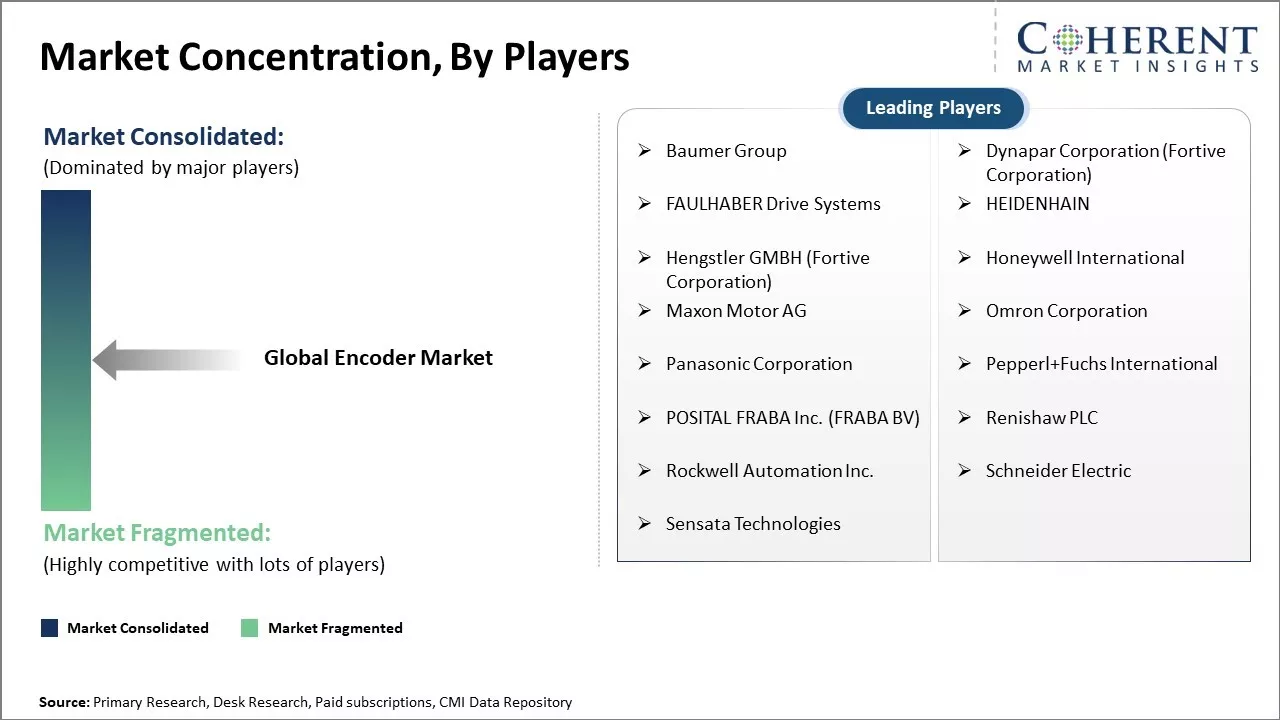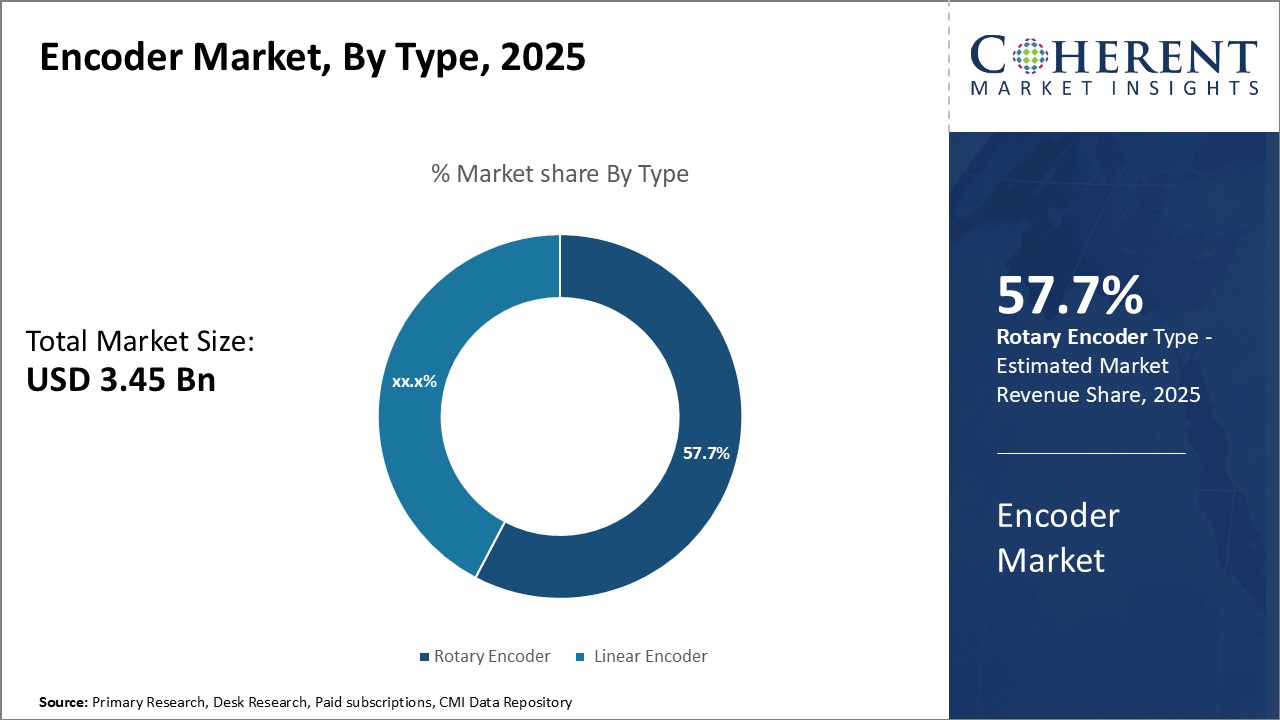The global encoder market is estimated to be valued at US$ 3.19 Bn in 2024 and is expected to reach US$ 5.41 Bn by 2031, exhibiting a compound annual growth rate (CAGR) of 7.8% from 2024 to 2031.

To learn more about this report, request sample copy
The growing demand for motion control applications across industries, such as automotive, electronics, and healthcare, is expected to drive the market growth. Encoders find wide usage in rotational as well as linear motion systems used in equipment across these industries. Moreover, the rising adoption of automation driven by Industry 4.0 is further expected to create opportunities for growth in the market. Adoption of servo motors that majorly use encoders for position feedback is also promoting market expansion. However, availability of alternatives such as resolvers and linear variable differential transformers (LVDTs) can pose a challenge but innovative product offerings can help encoders gain an edge over alternatives during the forecast period.
Growing automation and industrial digitization
The adoption of industrial automation and digitization technologies across different industries has been rising significantly over the past few years. Manufacturing plants are increasingly automating their production processes and integrating various automated systems, such as robotics, machine vision, product handling equipment, and others, to improve production efficiency, reduce operational costs, and enhance product quality. This rising level of automation is propelling the demand for encoders as they are one of the most important components used in automated machinery and industrial robotics. Encoder technology helps provide feedback and measurements that are crucial for controlling automated systems accurately. Their ability to convert motion into electrical signals is making them indispensable for encoding speed, angle and linear position in automated assembly lines, CNC machines, motion control systems, and other automated equipment. As factories continue investing in initiatives like industrial IoT, predictive maintenance and smart manufacturing, the need for encoders will keep rising. Meanwhile, the integration of encoder technology is also enabling advanced applications like autonomous vehicles, drones, and other robotics systems that require precise motion and positional control. This mega trend of increasing industrial digitization worldwide will be a primary driver propelling the global encoder market forward in the coming years.

Get actionable strategies to beat competition: Get instant access to report
Rising implementation of servos and motion control systems
Another major factor driving the encoder market is the growing implementation as well as sophistication of servos and motion control systems across various industries. Precise motion control is highly important in diverse applications ranging from factory automation to medical devices. Servo motors along with feedback devices like encoders form the backbone of any motion control system. Their integration allows achieving controlled rotary or linear movement, speed and position accuracies. Over the past few decades, servo motor technology has significantly advanced in terms of performance and affordability. Meanwhile, industries are also implementing more complex motion requirements through coordinated multi-axis servo motor systems. As a result, the demand for feedback devices has been rising considerably. Encoders play a vital role in closed-loop motion control applications as they provide real-time feedback about the motor's position that is used by motion controllers to adjust motor operations accordingly. Emerging technologies like collaborative robotics, 3D printing machinery, complex packaging lines increasingly require high-precision motion profiles that rely on encoders integrated with advanced servos. The rising uptake of servo motors across manufacturing sectors as well as development of new motion-centric processes will augment lucrative business opportunities for encoder manufacturers.
Key Takeaways from Analyst:
The rising adoption of automation across various industries will be a key driver for demand. Industrial automation continues to accelerate with increasing use of robotics, motion control processes, and factory IoT technologies. All these rely heavily on precise encoder feedback for position, velocity, and motion control. The demand from the automotive sector is also growing steadily with applications in electric vehicles, advanced driver assist systems, and infotainment units.
However, growth could be hampered by the rising costs of raw materials used in encoder manufacturing. Metals like steel and aluminum that are used in encoders have seen significant price volatility over the past year due to supply chain issues. This remains a challenge for OEMs to keep production costs low. Competition is also intense from regional players offering cheaper alternatives, which might limit premiumization opportunities for global brands.
North America and Europe are also substantial markets driven by factory automation initiatives and the presence of encoder fabrication capabilities. Going forward, the fastest growth is expected from developing regions as their manufacturing sectors modernize with Industry 4.0 technologies requiring precise motion control.
Market Challenges: Complexity in design and implementation
Encoder technology has become increasingly sophisticated over the years to meet diverse industrial demands. However, the drive towards more complex and advanced designs has also introduced several challenges. Designing high-precision encoders that can offer nano-level resolution while withstanding harsh environmental conditions is no easy task. It requires intricate engineering and testing of multiple inter-dependent components like optics, electronics, and mechanics at the micro and nano scales. Any small defect or error during the manufacturing process can compromise the encoder's performance and lifespan. This increases the costs substantially.
Moreover, with greater complexity comes greater difficulty in implementation as well. Advanced encoders may not always be compatible with the infrastructure and setup of existing machinery. Integrating the encoder often requires retrofitting other supporting components or making customized modifications. This disruption adds to labor costs and downtime for industries that prioritize continuity of operations. Implementation problems are more common with bespoke encoder designs tailored for very specific industrial processes. Troubleshooting complex designs is also more time-consuming for technicians.
Market Opportunities: Integration with cloud computing and edge computing
Integration of cloud computing and edge computing provide great opportunities in the global encoder market. With more devices and endpoints generating data away from centralized cloud infrastructure, edge computing allows real-time processing of data closer to its source. This reduces latency issues and ensures business continuity. Many industrial applications such as robotics, factory automation, and IoT rely on low latency communication between devices. Edge computing fulfils this need by analyzing and acting on data locally without transmitting everything to a cloud platform.
Encoders are critical components that generate digital signals vital for edge and cloud applications. The ability of encoders to seamlessly integrate with edge and cloud environments allow customers to scale solutions and leverage pooled computing resources without worrying about infrastructure management. Edge devices installed with encoders can autonomously operate based on local conditions and requirements, while also connectivity to cloud platforms for centralized monitoring and analytics. This enables enterprises across industries like manufacturing, healthcare, utilities, etc. to build applications spanning entire networks of linked edge nodes that can collectively process high volumes of data.

Discover high revenue pocket segments and roadmap to it: Get instant access to report
Insights By Type - Rotary encoders lead encoder types due to versatility and high precision
In terms of type, rotary encoder is expected to contribute 57.2% share of the market in 2024 owing to its versatility and high precision capabilities. Rotary encoders can detect rotational movement along one or multiple axes, making them well-suited for a wide range of industrial and commercial applications. They are commonly used in machinery components like motors, pumps, robots, and CNC machines to provide feedback on position, velocity, and direction of rotating shafts. Compared to linear encoders, rotary encoders offer 360-degree sensing which allows for continuous rotation monitoring. This complete range of motion detection enables functions like incremental counting or absolute position feedback. Additionally, rotary encoders feature high resolution capabilities from nanometers up to several millimeters depending on the model, ensuring precise output even at fast rotational speeds. Their compact circular designs also allow for easy integration into space-constrained equipment. Owing to these advantages, rotary encoders see extensive demand across industries for motion control, automation, and other operations requiring rotational motion tracking.
Insights By Technology - Magnetic encoder technology dominates due to cost effectiveness
In terms of technology, magnetic is expected to contribute 51.7% share of the market in 2024 owing to its cost effectiveness for general positioning applications. Magnetic encoder technology utilizes the interaction between a sensor and magnetic fields or targets to detect displacement or movement. Compared to alternative technologies like optical or capacitive encoders, magnetic encoders provide positioning sensing at lower cost due to fewer components and simpler designs. Their magnet-based systems can operate reliably in applications not suitable for optical methods, like dirty or wet environments with contamination risks. Additionally, magnetic encoders require no external light source and have greater resistance to shock and vibration. These rugged qualities coupled with affordable pricing have made magnetic encoders a popular choice for everyday factory automation needs. Areas like packaging machinery, material handling equipment, assembly lines, and CNC machines widely employ low-cost magnetic encoders to monitor linear or rotary positioning for basic motion control tasks.
Insights By End-use Industry - Industrial sector drives the encoder demand owing to diverse automation requirements
In terms of end-use industry, industrial is expected to contributes 45.1% share of the market owing to diverse automation needs across manufacturing. The industrial sector encompasses a broad range of manufacturing processes and machinery where real-time position, speed, or motion feedback is essential for automation and quality control. Application areas include robotics, assembly lines, machine tools, packaging equipment, lifting systems, and automated guided vehicles (AGVs). Encoders provide the precise sensing capabilities required to automate operations like cutting, blending, welding, assembly, inspection, and logistics handling in industrial environments. Their ability to track linear or rotational movements with nanometer resolution allows machinery to run repeatably with high tolerance. Additionally, encoders withstand harsh factory conditions through sealed, ruggedized designs appropriate for industrial equipment. Growing global industrial automation and emphasis on Industry 4.0 further stimulates encoder demand as manufacturers increasingly adopt smart technologies and integrate IIoT. With encoders as a key enabling component, industrial machinery globally relies on the technology for flexible, efficient production automation.

To learn more about this report, request sample copy
North America has established itself as the dominant regional market for encoders globally. The region is expected to account for 35.2% of the market share in 2024. The region is home to several leading multinational companies operating in encoder manufacturing space such as Dynapar, Hans Turck, Baumer, and BEI Encoder. These companies have significant R&D investments and manufacturing facilities located in the U.S. and Canada. Furthermore, the region has highly developed end-use industries such as automation, manufacturing, and semiconductor fabrication that are early adopters of advanced automation technologies utilizing encoders.
The Asia Pacific region, particularly countries like China, is witnessing the fastest growth in the encoder market space. There are multiple factors contributing to the regional market growth. To begin with, the region is a global manufacturing powerhouse led by China which is driving immense demand for automation technologies like encoders from industries. Secondly, domestic players in China have emerged as serious low-cost competitors to Western brands. Companies, such as Jinan Kaisi, Hangzhou Sky-marking Sensor, and Guangzhou Houfeng Instrumnets, have captured significant market share in Asia Pacific utilizing their competitive pricing strategy while offering products comparable to major international brands. Thirdly, the Chinese government is strongly supporting the growth of smart and advanced manufacturing through initiatives like 'Made in China 2025' which is benefiting encoder market.
Lastly, the export market of Asia Pacific is also growing rapidly. For example, Chinese encoder manufacturers are exporting their products in large volumes to developing nations and regions with higher demand but limited manufacturing capabilities like Africa, South America, and Southeast Asia. Their ability to offer competitive pricing is making Chinese encoder brands increasingly popular even in export markets, thereby driving the Asia Pacific encoder market growth. On the other hand, established North American and European players are also leveraging lower cost manufacturing bases in Asia Pacific to increase their price competitiveness and access high-growth Asian and export markets.
Encoder Market Report Coverage
| Report Coverage | Details | ||
|---|---|---|---|
| Base Year: | 2023 | Market Size in 2024: | US$ 3.19 Bn |
| Historical Data for: | 2019 To 2023 | Forecast Period: | 2024 To 2031 |
| Forecast Period 2024 to 2031 CAGR: | 7.8% | 2031 Value Projection: | US$ 5.41 Bn |
| Geographies covered: |
|
||
| Segments covered: |
|
||
| Companies covered: |
Baumer Group, Dynapar Corporation (Fortive Corporation), FAULHABER Drive Systems, HEIDENHAIN, Hengstler GMBH (Fortive Corporation), Honeywell International, Maxon Motor AG, Omron Corporation, Panasonic Corporation, Pepperl+Fuchs International, POSITAL FRABA Inc. (FRABA BV), Renishaw PLC, Rockwell Automation Inc., Schneider Electric, and Sensata Technologies |
||
| Growth Drivers: |
|
||
| Restraints & Challenges: |
|
||
Uncover Macros and Micros Vetted on 75+ Parameters: Get Instant Access to Report
*Definition: The global encoder market is a market segment for encoder devices which are used to track motion and provide feedback to a control system. Encoders convert the angular or linear position of a rotating or moving object like a motor shaft or lead screw into digital signals that can then be decoded to provide positioning information. The global encoder market includes optical, magnetic, and other types of encoders used across various industries like automotive, electronics, manufacturing, food and beverage, and others worldwide for motion control applications in machinery, robotics, motor drives, instrumentation, and various mechatronic systems.
Share
About Author
Suraj Bhanudas Jagtap
Suraj Bhanudas Jagtap is a seasoned Senior Management Consultant with over 7 years of experience. He has served Fortune 500 companies and startups, helping clients with cross broader expansion and market entry access strategies. He has played significant role in offering strategic viewpoints and actionable insights for various client’s projects including demand analysis, and competitive analysis, identifying right channel partner among others.
Missing comfort of reading report in your local language? Find your preferred language :
Transform your Strategy with Exclusive Trending Reports :
Frequently Asked Questions
Joining thousands of companies around the world committed to making the Excellent Business Solutions.
View All Our Clients